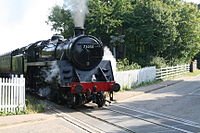Halsuntrian Railways Service: Difference between revisions
Halsuntria (talk | contribs) |
Halsuntria (talk | contribs) |
||
| Line 11: | Line 11: | ||
===1820-1900=== | ===1820-1900=== | ||
In the 1820's is when trains were greatly expanded to be faster and by the 1830's reached speeds of 30 miles an hour. It was in the 1830's that trains were expected to be used for commercial use transporting people from city to city, town to town, and trains greatly succeeded in doing so. They were able to get people places faster than ever before and engineers by the names of Linus Hyler, Thomas Haschak & Babri Vatsy would pave the way for the innovation of the train and rail. Those three would not only make trains faster, sleeker and more efficient; they would make rails, bridges, signals, everything that would make trains run more efficient and are a prime reason for trains being as wide used as they are today. | |||
===1900's=== | ===1900's=== | ||
===21st Century=== | ===21st Century=== | ||
Revision as of 15:37, 8 February 2021
The Halsuntrian Railway Service (HRS) is the general term for all railways in Halsuntria, regardless of size. The HRS is the most used mode of interstate transportation in Halsuntria with about 20,000 more passengers than highways each year. The HRS has about 25,000 miles of rail in Halsuntria which can be divided into standard (1372 mm), small (762 mm), and wide (1668 mm) gauges. The standard gauge is the most used in Halsuntria as it makes up most of the rails that goes in and out of cities, the next is small which is the large majority of regional routes and overall smaller lines mostly throughout the countryside, it is noted that about 1/3 of these are heritage railways with the sole purpose for tourism. The least used is wide gauge which has a variety of uses and it is mainly for odd jobs such as at a harbor or other industrial facility.
Steam and electric trains are used almost equally when it comes to passenger transport while freight trains are almost exclusively diesel. Despite steam trains being generally slower than electric, they are loved by tourists as well as Halsuntrian citizens as it is unique and has almost became a part of Halsuntrian culture to have steam trains. Trains in general have became a huge part of Halsuntria's history with them being the main mode of transportation and that is due to them having a rich history in Halsuntria dating all the way back to the 1690's.
History
The story of trains in Halsuntria date all the way back in the 1710's with the bringing over of the steam engine and goes all the way to today where they have become the most beloved mode of transport in all Halsuntria.
Pre 1820's
In 1711, a Halsuntrian by the name of Lautpils Meroick brought over a steam engine from Thuadia and learned how to use it and fascinated about the idea of using it for transport. He died when one of his engines caught fire and blew up his workshop but he had made sizable progress when his son, Daugen Meroick, took over after his death. When Daugen died in 1779 he had garnerd attention from the public and government to continue the work to make a steam transport. In 1796, a steam car was invented by putting a steam engine on four wheels, it was incapable of carry people and only went 5 miles a hour but was a step in the right direction. Already being used, rails from horse-drawn railways would become the next step for steam engine to go, and they would arrive in a little less than a decade.
In 1804, the train was invented. In Perced, the same town the Meroick's lived, the Meroick was put on the rails using coal as power, it worked at a local iron mill. Over the next 15 years, the train would not get much faster but it would become more widely used as passenger transport and as amusement for the Halsuntrians.
1820-1900
In the 1820's is when trains were greatly expanded to be faster and by the 1830's reached speeds of 30 miles an hour. It was in the 1830's that trains were expected to be used for commercial use transporting people from city to city, town to town, and trains greatly succeeded in doing so. They were able to get people places faster than ever before and engineers by the names of Linus Hyler, Thomas Haschak & Babri Vatsy would pave the way for the innovation of the train and rail. Those three would not only make trains faster, sleeker and more efficient; they would make rails, bridges, signals, everything that would make trains run more efficient and are a prime reason for trains being as wide used as they are today.

